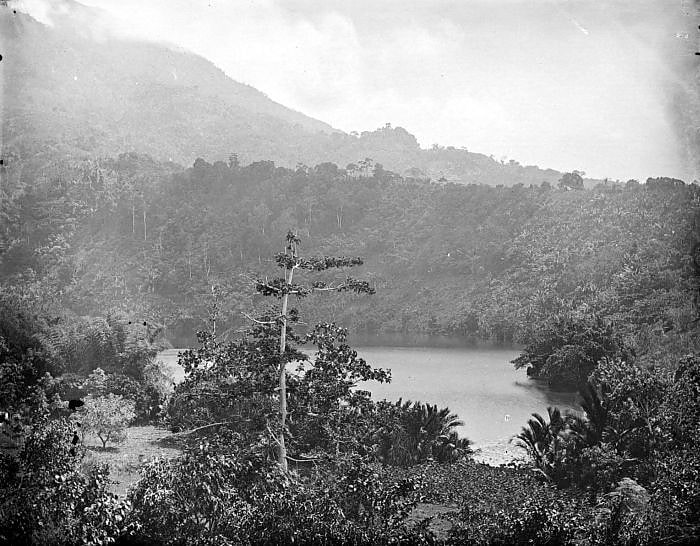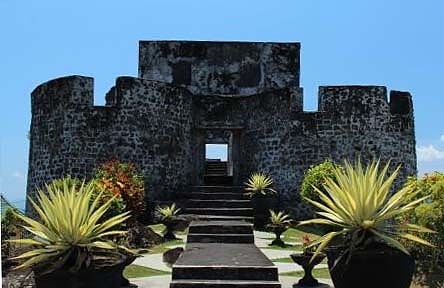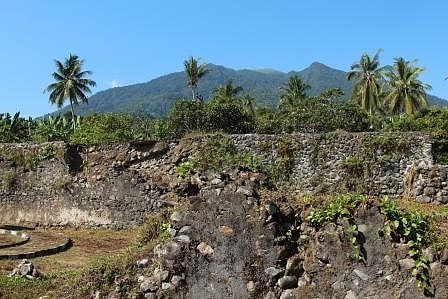Discover 4 hidden attractions, cool sights, and unusual things to do in Ternate (Indonesia). Don't miss out on these must-see attractions: Tolire Lake, Gamalama, and Fort Tolukko. Also, be sure to include Fort Kastela in your itinerary.
Below, you can find the list of the most amazing places you should visit in Ternate (North Maluku).
Table of Contents
Tolire Lake

Lake. Tolire Lake is located in northwest Ternate, North Maluku, Indonesia. The lake is bordered by sheer cliffs.
Tolire Lake at the foot of Mount Gamalama, the highest volcano in North Maluku. The lake itself is composed of two sections which locals call Tolire Large and Small Tolire. The distance between them is about 200 meters.[1]
Gamalama

Stratovolcano in Indonesia. Gamalama is a near-conical stratovolcano that comprises the entire Ternate island in Indonesia. The island lies off the western shore of Halmahera island in the north of the Maluku Islands. For centuries, Ternate was a center of Portuguese and Dutch forts for spice trade, which have accounted for thorough reports of Gamalama's volcanic activities.
An eruption in 1775 caused the deaths of approximately 1300 people.
On December 4, 2011 Mount Gamalama erupted, ejecting material up to 2,000 meters into the air. Thousands of residents in nearby Ternate City fled due to ash and dust particles raining down on the town. Finally on December 27 some 4 people died and dozens injured from debris falls (lahar) after a month of activity.
More eruptions occurred in September 2012.
An eruption on December 18, 2014, deposited five centimeters of ash on the runway of Babullah Airport in Ternate, closing the airport.[2]
Fort Tolukko

Also known as: Benteng Tolukko
Fortress in Ternate City, Indonesia. Fort Tolukko is a small fortification on the east coast of Ternate facing Halmahera. It was one of the colonial forts built to control the trade in clove spices, which prior to the eighteenth century were only found in the Maluku Islands. It has been variously occupied by the Portuguese, the native Ternate Sultanate, the Dutch, the British and the Spanish. It was abandoned as a fort in 1864, renovated in 1996, and is now a tourist attraction.[3]
Fort Kastela

Also known as: Benteng Kastela
Fortress in Ternate City, Indonesia. Fort Kastela is a ruined fortress located at the southwest coast of Ternate. It is famous for being the first colonial fortification constructed in the Spice Islands of Indonesia. Built by the Portuguese in 1522, it is also referred to in different languages as São João Baptista de Ternate or Fortaleza de Ternate, Ciudad del Rosario or Gammalamma. Today it is locally known as Kastella/Kastela.
In April 1521, a fleet was dispatched by King Manuel I of Portugal from Lisbon under the command of Jorge de Brito. The fleet was given orders to intercept the Spanish fleet of Ferdinand Magellan while sailing towards the Spice Islands from the Americas. Upon making landfall, they were ordered to construct a fortress on Ternate and to establish the Portuguese pre-eminence in the region. The initial fort was named by the Portuguese after Saint John the Baptist, on whose feast day the first stone was laid in 1522. It was completed in 1523. The location selected was on the south-west coast of Ternate, near the Sultan's Court, but 7 km from the island's main reef-free harbor at Talangame. Kastella commanded three narrow passages through the encircling reefs, which allowed small crafts to arrive for loading cloves, but prevented larger vessels from closing sufficiently to bombard.
Several subsequent visitors described the fort as incomplete, and it was not until the governorship of António Galvão, commencing in 1536, that the defenses were improved significantly. After killing Ternate's Sultan Hairun in 1570, the Portuguese were besieged in their fort by forces of the new Sultan Baab for five years. In 1575, they handed over the fort and retreated to Ambon. Sultan Baab occupied the fort, renamed it as Gammalamma and converted it into his royal palace. Anticipating a Portuguese return, Sultan Baab extensively modified the defenses into a substantial fortress, and constructed an additional fort 5 km to the east, known today as Fort Kota Janji.
In 1605, the newly arrived Dutch VOC captured Portuguese forts on Ambon and Tidore and established a trading base on Ternate. The Spanish dispatched a strong expedition from the Philippines and recaptured Kastella, taking hostage Sultan Saidi Berkat and exiling him to Manila in March 1606. They further modified the Gammalamma defenses into a powerful fortress and renamed it as Ciudad del Rosario. Dutch Admiral Paulus van Caerden, captured by the Spanish in 1610 and held in Kastella, regarded it as "invulnerable." When the Spanish departed from the Spice Islands in 1663, they partially destroyed the defenses which were then occupied by the Dutch.
Today the site consists of ruins spread over a large area, scattered with local houses and bisected by the main island road. There is a monument for the 1575 Ternatean victory over the Portuguese, and sections of the old Portuguese walls and bastions from the Spanish period can also be seen.[4]